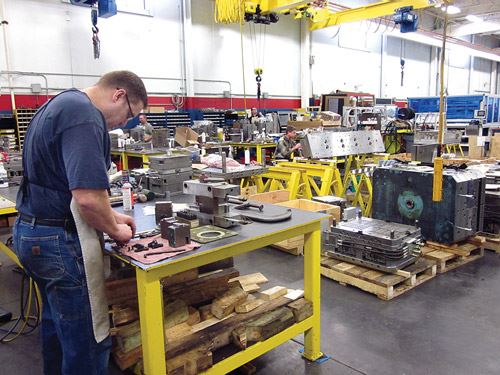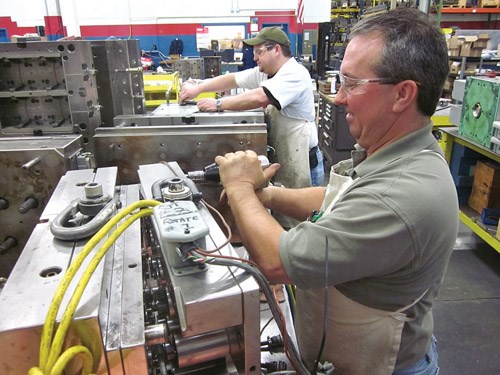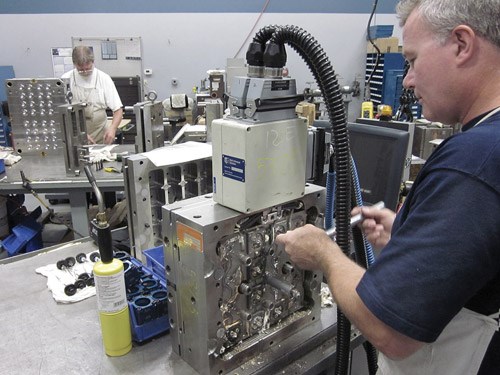It is big news when an OEM decides to move a substantial number of existing molds from one molding operation (either their own in-house/captive facility or an outsourced molder) to a selected custom molder.
Mold transfers—particularly large ones—require upfront planning, communications and investments that yield the goals and expectations of the project. A complete understanding of the OEM’s goals must be in place at the injection molding operation taking responsibility for the change in venue. The information and activities required leave no room for anything but complete cooperation and disclosure from both sides.
The eight phases of a transfer include:
1. Contractual agreement
2. Partnership
3. On-site assessment
4. Schedule
5. Safety stock
6. Equipment purchase/consigned equipment
7. Validation
8. Production molding
A contractual agreement should be established that provides legal commitment from both parties. The contents will protect the interest of all companies involved over the length of the agreement.
A dedicated and empowered team (see Transfer Program Management Team Sidebar, page xx) must be defined upfront based on the requirements of the project. Both companies must be willing to make whatever personnel arrangements are necessary to ensure success—forming a partnership with open lines of communication between the two management groups.
A detailed on-site assessment of the manufacturing operations at the current facility is required to develop a seamless transfer. During this time, the Project Management transfer team works with the current molding operation to thoroughly understand the production functions from order entry to shipment. This is an especially critical step. It is likely to be the only opportunity to capture the wealth of information that, in many cases, has not been properly documented. Molds that have run for years in the same press by the same operators are often taken for granted because they have run, seemingly successfully, for years.
The small shortcuts and down and dirty fix-ups are seldom noted and shared with management; instead, they become tribal knowledge. Only through observation and interrogation by appropriately experienced technicians (toolmakers and process engineers) are the actual production procedures understood and many hidden manufacturing sins revealed.
Based on what was learned from the on-site assessment, a transfer schedule will be developed. This again will be a joint effort as both parties must participate in its success. All parts, molds and associated production equipment will receive a scheduled date to transfer.
The originating production facility will be responsible to build safety stock per the production requirements of the transfer schedule. The amount of stock needed will be determined during the on-site assessment. The idea is to build enough safety stock that will allow for the tools and equipment to be transferred and validated at the destination facility. Typically, a six-week timeframe will work within the transfer schedule. It is likely that additional shifts and/or weekends will be needed to keep the safety stock build schedule on course.
The new molder may need to purchase any non-consigned equipment that may be critical to production of the transfer parts. Consignment equipment typically includes tooling and spares, fixtures, inspection gauges and all other product specific equipment. The new molder usually accepts standard maintenance responsibility on these items. Major tooling refurbishments will need to be quoted and submitted for approval.
The goal of validation is to gain customer approval on each part to be produced at the new molding facility. A process based on similarity to the existing manufacturing process and golden samples is typically initiated. Flexibility in this process must remain, as individual companies may require product specific production controls.
Upon validation approval, the new molder’s long-term production staff will manage and produce the products within the constraints of the contractual agreement per the projected volumes for each part in the transfer package.
Another factor to consider is what a tremendous impact a transfer program has on a molding operation’s preventive maintenance (PM)) shop. A molder’s PM shop is scheduled, staffed and equipped to properly accommodate the cleaning, care, repair and refurbishment of active production molds. The arrival of five, 50 or 500 tools—each requiring an absolutely thorough mold and mold component inspection and evaluation—is an outside-of-the box event that will dominate the shop schedule. If existing production molds are to be serviced as always, the molding facility’s accounting department must face the prospect of a dramatic increase in overtime or the commissioning of an outside tool shop to assist. Depending on the number of molds involved, it is likely that the transfer program will require a temporary full-time project management role for a PM toolmaker.
During the inspection and evaluation phase, the PM shop is likely to discover many hidden sins—creative use of shim stock and other temporary “band-aids” that tend to remain permanent, for example. It is at this point, after thorough documentation of steel dimensions and analysis of golden parts, that the PM shop must begin repairing the tools so that the parts made meet the customer’s specifications. Often, because molding facilities have their own unique mix of equipment and working methodology, the PM shop will also add the necessary changes to the tools so they will run efficiently in their new environment—venting, polish, sprue pullers, delayed ejection, etc.
In conclusion, the toolmaker and the tool shop play a critical role in the successful transfer of production molds from one facility to another. The entire basis for accomplishment rests on the capabilities of the molds. Determining the actual status of each mold—and the condition and performance of each mold component—is required to enable continued profitable production of plastic parts, which meet the OEM’s quality conditions.
Related Content
Tackling a Mold Designer Shortage
Survey findings reveal a shortage of skilled mold designers and engineers in the moldmaking community, calling for intervention through educational programs and exploration of training alternatives while seeking input from those who have addressed the issue successfully.
Read MoreMaking Quick and Easy Kaizen Work for Your Shop
Within each person is unlimited creative potential to improve shop operations.
Read MoreOEE Monitoring System Addresses Root Cause of Machine Downtime
Unique sensor and patent-pending algorithm of the Amper machine analytics system measures current draw to quickly and inexpensively inform manufacturers which machines are down and why.
Read MoreLeading Mold Manufacturers Share Best Practices for Improving Efficiency
Precise Tooling Solutions, X-Cell Tool and Mold, M&M Tool and Mold, Ameritech Die & Mold, and Cavalier Tool & Manufacturing, sit down for a fast-paced Q&A focused on strategies for improving efficiencies across their operations.
Read MoreRead Next
How to Use Continuing Education to Remain Competitive in Moldmaking
Continued training helps moldmakers make tooling decisions and properly use the latest cutting tool to efficiently machine high-quality molds.
Read MoreHow to Use Strategic Planning Tools, Data to Manage the Human Side of Business
Q&A with Marion Wells, MMT EAB member and founder of Human Asset Management.
Read More













.jpg;maxWidth=300;quality=90)








.jpg;maxWidth=970;quality=90)